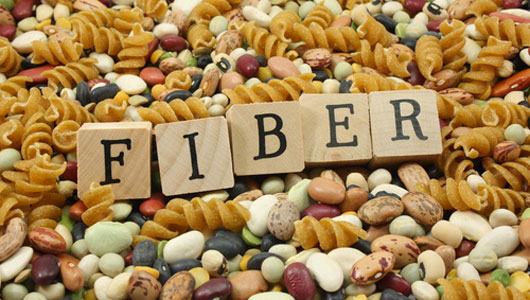Fiber (formerly called roughage) is a general term that refers to the substances in food resisting digestion. The amount of fiber in a food is determined by its plant source and the amount of processing it undergoes. The more a food is processed, the more the fiber is broken down and the lower the fiber content. Dietary fiber is the actual residue of plant food that resists digestion in the human body. There are two kinds of fiber: soluble fiber, which forms a gel when mixed with water, and insoluble fiber, which passes through our intestines largely intact and unchanged. Each plant food usually contains a mixture of both fiber types.
Soluble fiber has several favorable effects. Because it forms gels in water, it adds thickness to the contents of the stomach and may slow emptying, thus prolonging the sense of fullness and helping control appetite. Numerous studies show that eating oat bran cereal or oatmeal everyday can lower blood cholesterol due to their soluble fiber content. Diets high in fiber improve blood glucose control, lower insulin requirements and decrease blood pressure in people with diabetes. Soluble fiber also slows the absorption of sugars from the small intestine, which has a large effect on maintaining energy levels by avoiding insulin surges. Good sources of soluble fiber are fruits, vegetables and grains. Specific foods include pears, oranges, apples, prunes, dried beans, cauliflower, zucchini, sweet potatoes, and oat bran or oatmeal.
Insoluble fiber adds bulk to the contents of the intestine. This speeds the transit time of a meal’s remnants through the small and large intestines. This, in turn, offers several important health benefits.
- It helps prevent constipation because insoluble fiber attracts water into the digestive tract, thus softening the stool. This reduces the pressure in the lower intestine, creating less likelihood of hemorrhoids.
- It helps prevent compaction of food in the intestines, which could obstruct the appendix and lead to appendicitis.
- It stimulates muscle tone in the intestinal wall, which helps prevent diverticulitis, a condition where the intestines bulge and rupture.
- It may reduce the chances of colon cancer. Shorter transit time reduces the exposure of the intestines to cancer-causing agents in the food. Insoluble fiber also stimulates the secretion of mucus in the colon. Mucus coats the colon wall and may provide a barrier that keeps cancer-causing agents from reaching the colon’s cells.
The best source of insoluble fiber is wheat bran. Other good sources include whole grains, dried beans and peas, and most fruit and vegetables, especially those eaten with the skin. The American Institute for Cancer Research linked 35% of all cancers to diet. In a review of 156 studies, 128 showed that fruits and vegetables offered significant protection against cancers of the lung, colon, breast, cervix, esophagus, oral cavity, stomach, bladder, pancreas, and ovaries. How much fiber? Most Americans consume between 10 and 13 grams of dietary fiber per day. Some experts recommend this level be raised to as high as 35 grams. The DVR for fiber is 25 grams for a 2000-calorie diet.
As with most other nutrients, fiber can be consumed in excess. Indiscriminate consumption of fiber may interfere with the body’s ability to absorb other essential nutrients. A high intake of dietary fiber, for example, 60 grams per day, also requires a high intake of water.
Fiber Content of Selected Foods:
Apple, with peel 4.2
Banana 3.3
Blackberries (1 cup) 9.7
Dates (1 cup) 15.5
Grapes 1
Orange 2.9
Peach, peeled 2
Pear, with skin 4.9
Prunes, dried (10) 13.5
Raisins, seedless (1 cup) 9.6
Wheat bread (1 slice) 1.4
Rye bread (1 slice) 1.65
Whole Wheat (1 slice) 3.17
White bread (1 slice) 0.68
Instant Oatmeal (1/2 cup) 4
Bran Flakes (2/3 cup) 5
Cheerios (1 1/4 cup) 2
Corn Flakes (1 cup) 1
Raisin Bran (1/2 cup) 4
Rice Krispies (1 cup) Trace
Lima Beans (1/2 cup) 4.6
Green Beans (1 cup) 3.1
Corn, canned (1/2 cup) 6.3
Garbanzo Beans (1 cup) 8.6
Navy Beans (1 cup) 16.5
Baked Potato, with skin 4.4
Tomato 2.2
Carrot 2.0
Make sure to eat your fiber so that you will stay healthy long into your life! Fiber is a FANTASTIC way to CONTROL YOUR APPETITE! If you’re not eating fiber and protein, you will be hungrier more often!! Remember soluble fiber is what lowers cholesterol, while insoluble fiber keeps you regular!





